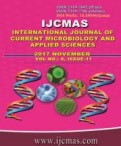


 National Academy of Agricultural Sciences (NAAS)
National Academy of Agricultural Sciences (NAAS)

|
PRINT ISSN : 2319-7692
Online ISSN : 2319-7706 Issues : 12 per year Publisher : Excellent Publishers Email : editorijcmas@gmail.com / submit@ijcmas.com Editor-in-chief: Dr.M.Prakash Index Copernicus ICV 2018: 95.39 NAAS RATING 2020: 5.38 |
With the changing climate, disease scenario has been rapidly changing in a given environment. Some of the minor pest and diseases are playing greater role in rice ecosystem. Sheath blight Sheath blight, under high rainfall areas, is becoming fatal to the rice production. As there is no true resistance yet been identified for this disease, farmers are still dependent on chemical management. This study includes In-vivo analysis of seven new generation chemicals to test their efficacy in altering the host physiological traits in order to manage sheath blight, the devastative disease of rice caused by Rhizoctonia solani. Chemical treatment was given twice at 15 days interval. The significant change in the physiological traits in terms of increase in chlorophyll content (AUSDC-817) and reduction in canopy temperature (AUCTPC-575) was observed in treatment plot Azoxystrobin 23% SC with highest projected yield (6.9t/ha), Benefit Cost ratio and maximum disease reduction (69.27%) followed by the Tebuconazole 50% + Trifloxystrobin 25%WG with 6.67t/ha projected yield, 1:0.88 BCR and 68% disease reduction.
 |
 |
 |
 |
 |